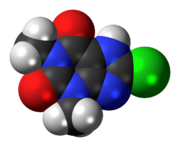Chemistry:8-Chlorotheophylline
 | |
 | |
| Clinical data | |
|---|---|
| Routes of administration | Oral |
| ATC code |
|
| Legal status | |
| Legal status |
|
| Identifiers | |
| |
| CAS Number | |
| PubChem CID | |
| ChemSpider | |
| UNII | |
| ChEBI | |
| ChEMBL | |
| Chemical and physical data | |
| Formula | C7H7ClN4O2 |
| Molar mass | 214.61 g·mol−1 |
| 3D model (JSmol) | |
| |
| |
| | |
8-Chlorotheophylline, also known as 1,3-dimethyl-8-chloroxanthine, is a stimulant drug of the xanthine chemical class, with physiological effects similar to caffeine.[1] Its main use is in combination (salt) with diphenhydramine in the antiemetic dimenhydrinate (Dramamine). Diphenhydramine reduces nausea but causes drowsiness, and the stimulant properties of 8-Chlorotheophylline help reduce that side effect.[2]
Despite being classified as a xanthine stimulant, 8-chlorotheophylline can generally not produce any locomotor activity above control in mice and does not appear to cross the blood-brain barrier well.[citation needed]
The 8-chloro modification is not selected for pharmacological properties; instead, it was to raise the acidity of the xanthine amine group enough to form a co-salt with diphenhydramine.[2]
The drug is also sold in combination with promethazine, again as a salt.[3]
References
- ↑ "Adenosine receptors and behavioral actions of methylxanthines". Proceedings of the National Academy of Sciences of the United States of America 78 (5): 3260–4. May 1981. doi:10.1073/pnas.78.5.3260. PMID 6265942. Bibcode: 1981PNAS...78.3260S.
- ↑ 2.0 2.1 Cusic, John W. (3 June 1949). "Note on the Chemistry of Dramamine". Science 109 (2840): 574. doi:10.1126/science.109.2840.574.a. PMID 17743285.
- ↑ https://www.ebi.ac.uk/chebi/searchId.do?chebiId=8461 "The anti-emetic action of both the hydrochloride and the teoclate (8-chlorotheophylline) salts is used for the prevention of nausea in cases of motion sickness and post-operative vomiting."
 |

